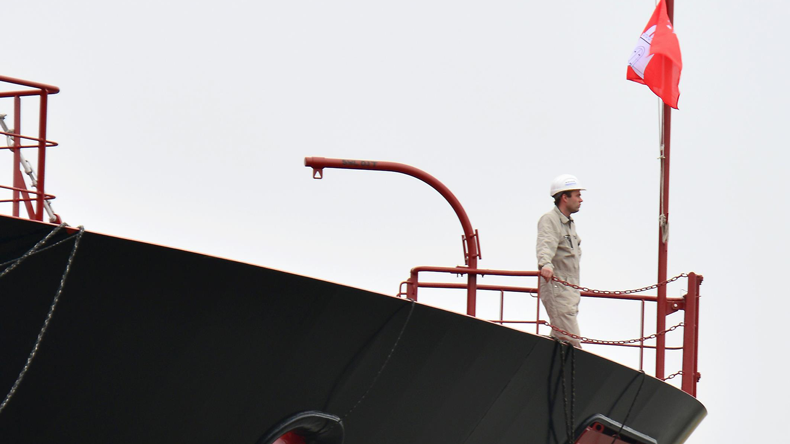From the News Desk: Shipping forecasts slashed and crew change rules relaxed
Analysts are rapidly revising previous projections for 2020 as the impact of coronavirus grips the shipping sector
Promising outlooks for a ‘V-shaped’ recovery from coronavirus now look overly optimistic as expectation sets in that the global economy is likely to see a significant downturn
JUST a few weeks ago, when the coronavirus pandemic was largely confined to Asia, a number of analysts and industry officials were touting the possibility of a strong recovery in trade as early as the second quarter of 2020. Those hopes now look to be well and truly dashed with each new measure introduced by governments around the world to try to slow and contain the outbreak.
This is certainly being reflected in revised analyst projections for the year ahead across all shipping sectors.
In its latest analysis of the impact of the pandemic on container demand, Sea-Intelligence has reiterated its view that liner shipping companies will see a 10% reduction in volumes this year as economies fall into recession due to the containment measures being taken.
Carriers had initially thought that the outbreak in China meant that the impact would only be on the supply side and that when factories returned to work there would be a rapid uptick in volumes as supply chains sought to restock inventories.
But Sea-Intelligence notes that in the US, the inventory-to-sales ratio stands at 1.35, 10% higher than where it was before the 2008 financial crisis. During the crisis, inventories were run down by almost one fifth.
“The difference this time is that the impact on demand will be much sharper, as businesses and consumers have been forced to curb spending within a very short time window,” Sea-Intelligence said.
“How quickly inventories can be reduced is an open question, in an environment where consumers are not only experiencing curfews and lockdowns but are also facing substantial uncertainty in relation to their job situation going forward.”
This situation would lead to a reduction in demand for containerised freight as cargo owners ran down existing stock levels rather than ordering new shipments.
Echoing the Sea-Intelligence view, Orient Overseas International Ltd, part of state-owned conglomerate China Cosco Shipping Corp, warned in its annual results analysis that the outbreak “creates a tremendous amount of uncertainty”.
“If the epidemic is further escalated globally and lasts for a long time, the medium- and long-term impact will be more extensive and significant, and the growth of the global economy and container shipping demand will decline,” it said.
Clarksons, meanwhile, reduced down its forecast for total world seaborne trade in tonne-miles growth in 2020 by 0.9% to 2.1%. This compares with an estimate of a 3.0% increase compared with 2019.
However, it added that further downgrades are likely and the potential low case scenario, which takes into account the possibility of the pandemic extending into the third quarter alongside a global recession that includes broad economic impacts in Europe and the US as well as a drop in consumer confidence, sees a negative impact of -0.2%.
Global ratings agency Moody’s also added to concerns for the industry, changing its outlook for global shipping to negative from stable, reflecting its expectations for fundamental business conditions over the next 12 to 18 months.
Moody’s predicts that rated shipping companies’ earnings before interest, taxes, depreciation and amortisation will decline by around 6%-10% in 2020 compared with growth of almost 40% in 2019 due to the expected impact of the virus on Chinese manufacturing output as well as demand for coal and iron ore in China, especially during the first half of 2020.
Moody’s also predicts that if the outbreak worsens there is downside risk of a 25%-30% decline in profits, similar to levels last seen during the Hanjin Shipping bust of 2016.
Shipping firms are taking measures to lessen the financial impact where possible. On Friday, container line Maersk suspended guidance because of the virus, saying it expected earnings before interest and tax to fall by $1.4bn.
DFDS, a Danish ferry, ro-ro and ro-pax operator, scrapped its outlook and dividend the day before, as tanker operator Stolt-Nielsen also withdrew its dividend.
On Monday, Oslo-listed ro-ro and car carrier operator Wallenius Wilhelmsen said it will withdraw its dividend, recycle up to four vessels and place up to 10 in cold layup as it seeks to preserve cash.
Crew changes & other restrictions
Meanwhile, China’s State Council has said that the government is aiming for a further relaxation of crew change restrictions at ports for domestic crew members.
It is targeting about 10,000 Chinese crew members whose service agreements or contracts will expire by the end of May and are due for shore leave. “How to do the virus-control work well for the entry of these seafarers is one of our key tasks right now,” said China Maritime Safety Administration deputy director Yang Xinzhai at a press conference.
The remarks came after the country’s transport ministry, which oversees the CMSA, said last week that it would co-ordinate an effort with all relevant parties to solve the issue in an ad hoc approach. Shanghai, home to the world’s busiest container port, subsequently published rules that allow crew replacement, although they are subject to a 14-day quarantine period.
However, any change of foreign crew members who have stayed in countries with severe infections in the past 14 days will, in principle, not be arranged at Chinese ports, according to Mr Yang.
Industry sources say that although the MoT has issued a policy guideline on managing crew changes in the midst of the coronavirus outbreak. The implementation of the essential operational moves is still on a case-by-case basis and varies at different local ports.
Jiangsu Maritime Safety Administration recently said it had permitted a crew change on Josoco Star, a Hong Kong-flagged containership, a week ago at the port of Nanjing.
Lloyd’s List Intelligence data shows that the 1,043 teu ship is beneficially owned by Jiangsu Ocean Shipping Co, a company ultimately controlled by the provincial government in Jiangsu.
Brisbane in Australia eased some port entry restrictions on Monday following pressure from the liner industry. Maritime Safety Queensland will now allow vessels to call at the port of Brisbane except those from China and South Korea.
The policy of forcing ships to stay away for 14 days since they were last at an overseas port had caused routing disruptions and affected the supply chain. Last Wednesday, MSQ began watering down its draconian approach by announcing exemptions for vessels from New Zealand, Papua New Guinea and some southwest Pacific nations, but it ignored the global liner trade.
MSQ acknowledged that there has been “a disturbing trend of vessel cancellations into the port of Brisbane”, and that these potentially bring a range of unintended consequences to the Queensland economy.
Finally, seafarers and other transport workers should be exempt from travel bans imposed in the European Union, according to guidelines sent to governments by the European Commission.
“Transport workers, irrespective of their nationality and place of residence, should be allowed to cross internal borders,” the commission said in a new set of guidelines for governments published on Monday.
Governments should waive restrictions and the mandatory quarantine of transport workers that do not display symptoms, it added.
The EU’s executive body has asked governments to designate all of the internal border crossing points on the EU’s trans-European transport network, known as TEN-T, consisting of inland waterways, road and rail routes that connect ports, airports and multimodal terminals. TEN-T currently includes the UK.
Shipping and seafarer associations have called for crew to be exempt from EU travel bans. Several countries have announced plans to completely close their borders, while the EU wants to ban all non-essential travel to the bloc for 30 days.
Lloyd's List webinar
The economic tsunami of the coronavirus pandemic has delivered an unprecedented external shock to the macro outlook, affecting every aspect of international shipping in its wake.
While the situation remains fluid there is now a need to move beyond the daily headlines and examine the wider context and shipping-specific risks, including supply chain, the oil price war and the safety of crews.
Join Lloyd’s List experts as they share data and insights on the effects of coronavirus in the first of our interactive webinars titled ‘Coronavirus: the issues for shipping and their impact’, taking place this Thursday, 26 March.
Kicking off our expanded range of digital content and events looking in depth at the coronavirus crisis in the shipping sector, our panel for this online event includes Lloyd’s List managing editor Richard Meade, Christopher Palsson, head of consulting at Lloyd’s List Intelligence, and markets editor Michelle Wiese Bockmann.
For registration and additional details, follow this link.



